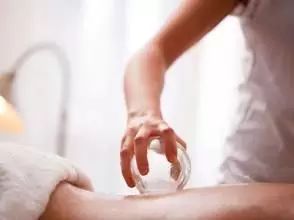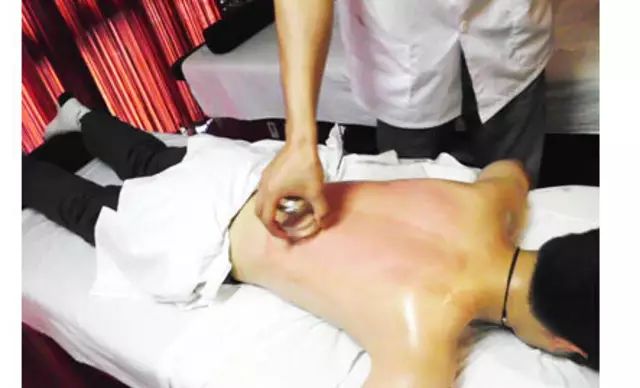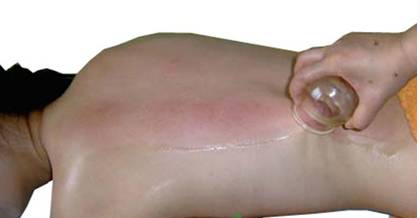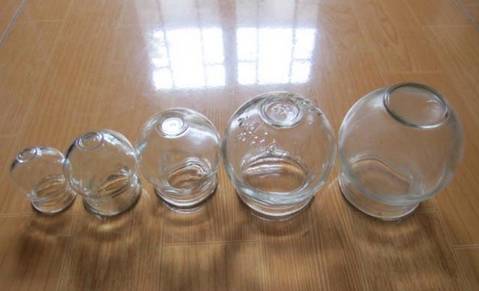
Cupping therapy is a form of cupping therapy.Cupping therapy uses cups as tools, applying an appropriate amount of lubricant to the rim of the cup and the affected area. By using heat to expel air from the cup, a negative pressure is created, allowing it to adhere to the skin. The cup is then moved back and forth over the affected area, causing the skin to become reddened or congested, thus preventing and treating diseases.
According to the theory in the “Shang Han Lun” that “Taiyang governs the exterior” and the concept that “the five zang organs are connected to the back,” as well as the folk practice of tapping the back to treat external pathogens, the use of back cupping therapy has shown good efficacy in treating acute rheumatic pain, dysentery, diarrhea, and colds.

Cupping can unblock meridians, promote qi and blood circulation, relieve fatigue, and enhance physical strength. At the same time, cupping can improve skin condition, enhance muscle endurance, and promote gastrointestinal motility, alleviating constipation.
For individuals with low immunity and poor digestive function, cupping can be a beneficial home health practice.
Before cupping, apply a layer of lubricant to the skin or the rim of the cup, then secure the cup in place.
Next, hold the bottom of the cup with your right hand, tilting it slightly, applying pressure to the back half of the cup while lifting the front half slightly. Move the cup in an up, down, left, and right motion, or in a clockwise and counterclockwise direction, until the skin in the cupping area becomes red, congested, or shows signs of bruising, at which point the cup can be removed.
Cupping therapy is generally divided into two types: local cupping and meridian cupping:
Local Cupping: Focuses on the affected area, performing small circular motions up, down, left, and right. For example, in cases of shoulder periarthritis, slow circular motions can be performed around the shoulder.
Meridian Cupping: Focuses on the meridians related to the affected area, performing larger range cupping treatments. For instance, for lumbar muscle strain, cupping can be performed along the governing vessel and bladder meridians with up and down movements.

-
When performing cupping, generally follow the order from top to bottom and from right to left, starting with the yang meridians before the yin meridians;
-
Do not apply too much suction initially; allow the recipient to feel a moderate amount of stimulation that they can tolerate, and gradually increase the pressure as the skin reddens;
-
During the process of pushing and pulling the cup, apply force to ensure the vacuum cup is pressed tightly before moving it, which will reduce discomfort;
-
After cupping, use a tissue to absorb the lubricant from the skin, pressing it against the skin rather than wiping it off;
-
After absorbing the lubricant, quickly dress to maintain warmth, which is also very important.
-
Performing qi restoration is crucial and should not be overlooked.
1. Individuals with skin allergies, ulcers, edema, or in areas with major blood vessel distribution should avoid this method.
2. Elderly individuals with multiple health issues should use this method with caution.
1. This therapy should be applied to larger areas with thick muscles. Before cupping, apply a lubricant such as petroleum jelly to the rim or skin to facilitate movement and reduce pain; this also helps prevent skin damage.
2. When pushing the cup, the movements should be slow and the force should be even, ensuring the cup is tilted at a certain angle. The back half should bear the weight while the front half is slightly lifted, allowing for greater resistance during movement.

3. It is advisable to use larger diameter cups with a round, thick, and smooth rim, preferably glass cups.
Interpretation of Cupping Marks:
1. Dark purple-black marks: Generally indicate insufficient blood supply and poor circulation with blood stasis.
2. Purple marks with spots: Generally indicate cold-induced blood stasis.
3. Marks with scattered purple spots of varying shades: Indicate qi stagnation and blood stasis.
4. Bright red marks: Generally indicate yin deficiency, qi and blood deficiency, or excess fire due to yin deficiency.
5. Dark red marks: Indicate high blood lipids and the presence of heat pathogens.
6. Gray-white marks that feel cold to the touch: Often indicate deficiency cold or damp pathogens.
7. Marks with skin texture or slight itching: Indicate wind or damp conditions.
8. Water vapor on the inner wall of the cup: Indicates dampness in that area.
9. Blisters appearing on the marks: Indicate internal dampness.
Warm Reminder: This platform shares health-related graphic information for reference and learning purposes only and should not be used as a basis for medical diagnosis. Please consult a physician for guidance if needed.


Public Account: zhw5243

